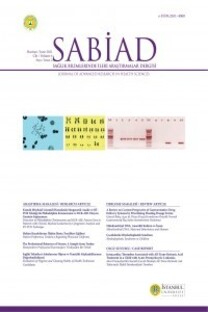microRNA AS A PROMISING POTENTIAL BIOMARKER FOR COLORECTAL CANCER
Objectives: Colorectal cancer (CRC)is a highly preventable and treatable disease when detected early. microRNAs (miRNAs) have the potential to serve as ideal noninvasive biomarkers. The aim of this study was to determine the diagnostic and prognostic biomarker potential of some miRNAs in serum samples of patients with CRC. Methods: 75 patients with CRC and 75 healthy individuals were enrolled in the study. Serum samples of the patients were obtained before and three months after surgery and once from healthy controls. The relative expression levels of miR-23, miR-223, miR-12469, and miR-150 in the serum of samples were determined using quantitative real-time PCR. The results were evaluated the receiver operating characteristic (ROC) curve analysis. Results: The expression level of mir-150 was significantly up-regulated in CRC compared to healthy group. The expression levels of miR-23 and miR-223 in serum were non-significantly up-regulated in CRC patients. But there were no changes in the expression level of miR-1246 in both groups. In addition, expression levels of miR-23 and miR-223 were significantly down-regulated three months after surgery, whereas miR-150 showed a significant level of up-regulation. However, there is no significant relationship between the serum levels of these genes and the clinical characteristics of CRC patients. By ROC curve analysis, only miR-23 and miR-150 were found to be able to distinguish CRC patients from controls with relatively high accuracy. Conclusions: Taken together, the expression levels of miR-23 and miR-150 in serum may be potential biomarker candidates for the diagnosis and prognosis of CRC.
microRNA AS A PROMISING POTENTIAL BIOMARKER FOR COLORECTAL CANCER
Objectives: Colorectal cancer (CRC)is a highly preventable and treatable disease when detected early. microRNAs (miRNAs) have the potential to serve as ideal noninvasive biomarkers. The aim of this study was to determine the diagnostic and prognostic biomarker potential of some miRNAs in serum samples of patients with CRC. Methods: 75 patients with CRC and 75 healthy individuals were enrolled in the study. Serum samples of the patients were obtained before and three months after surgery and once from healthy controls. The relative expression levels of miR-23, miR-223, miR-12469, and miR-150 in the serum of samples were determined using quantitative real-time PCR. The results were evaluated the receiver operating characteristic (ROC) curve analysis. Results: The expression level of mir-150 was significantly up-regulated in CRC compared to healthy group. The expression levels of miR-23 and miR-223 in serum were non-significantly up-regulated in CRC patients. But there were no changes in the expression level of miR-1246 in both groups. In addition, expression levels of miR-23 and miR-223 were significantly down-regulated three months after surgery, whereas miR-150 showed a significant level of up-regulation. However, there is no significant relationship between the serum levels of these genes and the clinical characteristics of CRC patients. By ROC curve analysis, only miR-23 and miR-150 were found to be able to distinguish CRC patients from controls with relatively high accuracy. Conclusions: Taken together, the expression levels of miR-23 and miR-150 in serum may be potential biomarker candidates for the diagnosis and prognosis of CRC.
___
- Grozescu T, Popa F. Prostate cancer between prognosis and adequate/proper therapy. J Med Life. 2017;10(1):5-12
